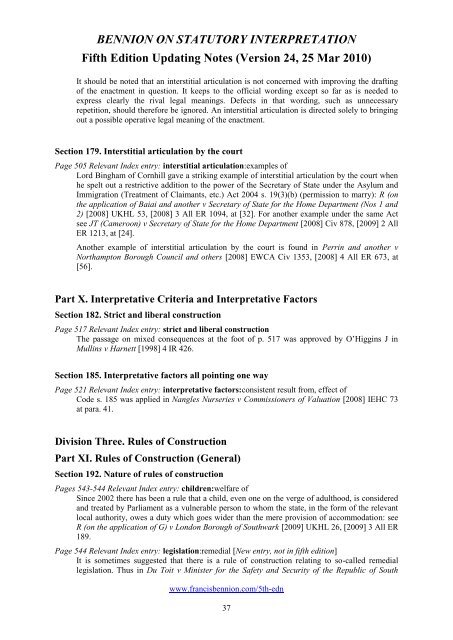BENNION ON STATUTORY INTERPRETATION ... - Francis Bennion
BENNION ON STATUTORY INTERPRETATION ... - Francis Bennion
BENNION ON STATUTORY INTERPRETATION ... - Francis Bennion
Create successful ePaper yourself
Turn your PDF publications into a flip-book with our unique Google optimized e-Paper software.
<strong>BENNI<strong>ON</strong></strong> <strong>ON</strong> <strong>STATUTORY</strong> INTERPRETATI<strong>ON</strong><br />
Fifth Edition Updating Notes (Version 24, 25 Mar 2010)<br />
It should be noted that an interstitial articulation is not concerned with improving the drafting<br />
of the enactment in question. It keeps to the official wording except so far as is needed to<br />
express clearly the rival legal meanings. Defects in that wording, such as unnecessary<br />
repetition, should therefore be ignored. An interstitial articulation is directed solely to bringing<br />
out a possible operative legal meaning of the enactment.<br />
Section 179. Interstitial articulation by the court<br />
Page 505 Relevant Index entry: interstitial articulation:examples of<br />
Lord Bingham of Cornhill gave a striking example of interstitial articulation by the court when<br />
he spelt out a restrictive addition to the power of the Secretary of State under the Asylum and<br />
Immigration (Treatment of Claimants, etc.) Act 2004 s. 19(3)(b) (permission to marry): R (on<br />
the application of Baiai and another v Secretary of State for the Home Department (Nos 1 and<br />
2) [2008] UKHL 53, [2008] 3 All ER 1094, at [32]. For another example under the same Act<br />
see JT (Cameroon) v Secretary of State for the Home Department [2008] Civ 878, [2009] 2 All<br />
ER 1213, at [24].<br />
Another example of interstitial articulation by the court is found in Perrin and another v<br />
Northampton Borough Council and others [2008] EWCA Civ 1353, [2008] 4 All ER 673, at<br />
[56].<br />
Part X. Interpretative Criteria and Interpretative Factors<br />
Section 182. Strict and liberal construction<br />
Page 517 Relevant Index entry: strict and liberal construction<br />
The passage on mixed consequences at the foot of p. 517 was approved by O‟Higgins J in<br />
Mullins v Harnett [1998] 4 IR 426.<br />
Section 185. Interpretative factors all pointing one way<br />
Page 521 Relevant Index entry: interpretative factors:consistent result from, effect of<br />
Code s. 185 was applied in Nangles Nurseries v Commissioners of Valuation [2008] IEHC 73<br />
at para. 41.<br />
Division Three. Rules of Construction<br />
Part XI. Rules of Construction (General)<br />
Section 192. Nature of rules of construction<br />
Pages 543-544 Relevant Index entry: children:welfare of<br />
Since 2002 there has been a rule that a child, even one on the verge of adulthood, is considered<br />
and treated by Parliament as a vulnerable person to whom the state, in the form of the relevant<br />
local authority, owes a duty which goes wider than the mere provision of accommodation: see<br />
R (on the application of G) v London Borough of Southwark [2009] UKHL 26, [2009] 3 All ER<br />
189.<br />
Page 544 Relevant Index entry: legislation:remedial [New entry, not in fifth edition]<br />
It is sometimes suggested that there is a rule of construction relating to so-called remedial<br />
legislation. Thus in Du Toit v Minister for the Safety and Security of the Republic of South<br />
www.francisbennion.com/5th-edn<br />
37

















